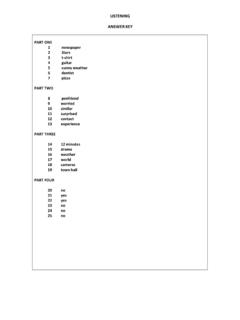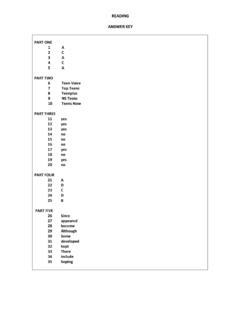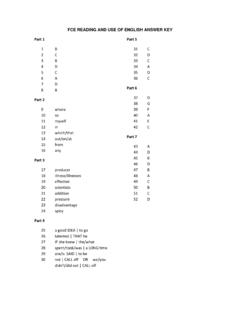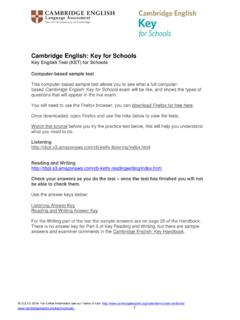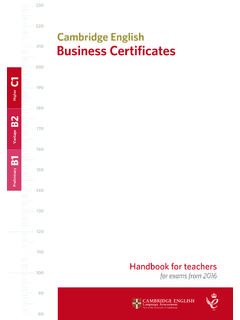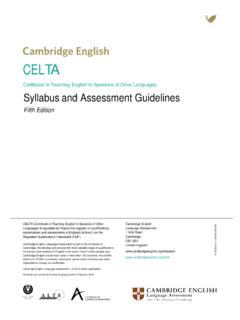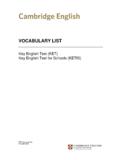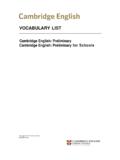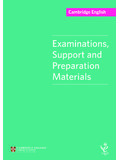Transcription of IELTS Speaking Part 1 Activity – teacher’s notes
1 UCLES 2009. This material may be photocopied (without alteration) and distributed for classroom use provided no charge is made. For further information see our Terms and Conditions. IELTS Speaking part 1 Activity teacher s notes Description An Activity to introduce Speaking part 1, focusing on what this part of the exam involves and the topics covered and to give students practice in talking about these topics using related vocabulary. Time required: 60 minutes Additional materials required: a large piece of paper, at least A4 size for each student pens Aims: to introduce part 1 Speaking and to explain its purpose. to practise answering the types of question that may be asked in this part of the exam. to develop students vocabularies Procedure 1. Explain or elicit what happens in part 1 Speaking and what the purpose of this might be. Based on this, elicit from the class what topics might be asked about, accommodation, friends, hobbies, food, work or.
2 Write these, spaced out, on the board. 2. Ask students to copy the topics in the form of a mind map onto a large piece of paper. As a class, decide on some typical useful vocabulary for each topic including nouns, verbs and adjectives, accommodation flat, neighbourhood, live, close to. 3. Divide the students into groups, with one group per topic (or divide into sub-groups with the same topic if you have a large class). Ask them to continue adding vocabulary to their topic. 4. After 5 minutes, circulate the mind maps around the class so each group has a new topic. Ask students to read the vocabulary and add any more they can think of. 5. Repeat step 4 as many times as suitable for your class size/time. 6. Write the following question on the board: Can you tell me about the kind of accommodation you live in? . Elicit more possible questions about accommodation and write them on the board.
3 ( How long have you lived there? What do you like about living there?) 7. Put the students into pairs and ask them to write down possible questions on the different topics. If possible, these pairs should be formed of students from different groups so they are working with someone new. Go round and check the questions. 8. Students ask and answer questions in pairs, one taking the role of examiner and one taking the role of candidate. Ask students to decide who the examiner is and who the candidate is for the first round. Explain that the candidate should try to give a full interesting answer consisting of 2 or 3 sentences to the questions on one of the topics. The examiner will choose the topic. Encourage students to use some (not all!) of the vocabulary just covered. Monitor and make a note of good examples of language, and language which could be improved on. UCLES 2009. This material may be photocopied (without alteration) and distributed for classroom use provided no charge is made.
4 For further information see our Terms and Conditions. 9. Each student exchanges roles. The new examiner asks questions about a different topic. Monitor and make a note of good examples of language and language which could be improved. 10. Hold a whole class feedback session about the examples of language you heard. 11. Ask students to change partners. Repeat the question and answer Activity with students choosing a different topic. This time encourage the students to give feedback on their partner s performance within their pair. 12. Repeat if time allows. 13. Ask students to reflect on how difficult they felt it was to do this Activity . Encourage them to feel comfortable and competent within these topic areas and re-emphasise that one of the purposes of part 1 is to settle the candidate into the exam. Point out that the topics should be fairly familiar. Ask follow up questions see below in suggested follow-up questions.
5 14. Stick the mind maps on the wall and add to them over time. Additional information The examiner introduces him/herself and checks the candidate s identity. Then s/he asks the candidate about familiar topics such as friends, hobbies and food. The purpose is to start the test, to try to put the candidate at ease and to find out some general background information about the candidate. Suggested follow-up activities/questions (and answers) 1. How do you feel talking about the topics in part 1? How easy or difficult is it? (usually students will realise that this part of the test is relatively familiar and that it is a useful way to get over their nerves) 2. How could you improve your performance in this part ? ( practise asking and answering questions on these topics with a partner in class, practise similar questions with other students/speakers of English outside class and whenever they meet someone new)
